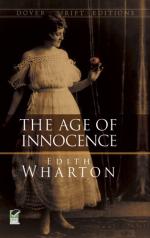|
This section contains 298 words (approx. 1 page at 400 words per page) |

|
The Age of Innocence Summary & Study Guide Description
The Age of Innocence Summary & Study Guide includes comprehensive information and analysis to help you understand the book. This study guide contains the following sections:
This detailed literature summary also contains Bibliography and a Free Quiz on The Age of Innocence by Edith Wharton.
Already a successful novelist in 1920 when she completed The Age of Innocence, Edith Wharton anticipated best-selling status for her new novel. The Age of Innocence, set in late nineteenth-century New York society, did indeed become a best-seller and won the Pulitzer Prize the following year. Wharton was the first woman to receive this high literary honor. The novel is both nostalgic and satirical in its depiction of old New York, with its often-stifling conventions and manners and its insistence on propriety. Wharton had written about old New York before in The House of Mirth and The Custom of the Country, but in The Age of Innocence she is less caustic in her criticism of its culture. Having worked diligently in relief efforts during World War I, Wharton recalled her formative years in New York society as a time of stability, even though that stability was the product of strict adherence to accepted rules of conduct.
Because of similarities between Wharton's style and that of her friend Henry James, The Age of Innocence is frequently compared to James' writing, especially his novel A Portrait of a Lady. Serious students are often encouraged to read the two titles in order to compare James's point of view to Wharton's distinctly feminine sensibility.
The Age of Innocence is regarded as a skilled portrait of the struggle between the individual and the community. It is also a work that explores the dangers and liberties of change as a society moves from a familiar, traditional culture to one that is less formal and affords its members greater freedom. The novel's staying power is generally attributed to its presentation of such universal concerns as women's changing roles, the importance of family in a civilized society, and the universal conflict between passion and duty.
Read more from the Study Guide
|
This section contains 298 words (approx. 1 page at 400 words per page) |

|



